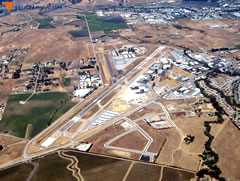 Plan for new terminal at SLO airport moves forward – San Luis Obispo County supervisors Tuesday authorized completing the design of a new terminal at the regional airport in San Luis Obispo even as the county’s airport services department faces an uncertain budget over the next five years
Plan for new terminal at SLO airport moves forward – San Luis Obispo County supervisors Tuesday authorized completing the design of a new terminal at the regional airport in San Luis Obispo even as the county’s airport services department faces an uncertain budget over the next five years
Supervisors held a wide-ranging discussion of the future of the airport, including its passenger terminal, which was described as functional but too small. Business leaders in San Luis Obispo are urging the county to expand services at the airport to attract and maintain businesses to the area.
The department’s most pressing need is to balance its budget. The department has a surplus of more than $500,000, but that could be erased over the next several years if expenses are not cut or additional revenues found, said Richard Howell, county airport services manager.
The county will consider a variety of options for increasing revenues such as increasing a jet fuel pumping tax and parking fees. The department will also look at reducing expenses, including the money it spends on law enforcement, aircraft rescue and firefighting, which constitute a quarter of the department’s budget.
Budgeting for an airport is difficult because many of the factors affecting it, such as the economy and oil prices, are beyond local control, Howell said.
Supervisors also moved ahead with plans to build a new, larger passenger terminal. The board has not given its final approval for the new facility, which will cost nearly $25 million, but has spent a little more than $1million in planning and design.
The earliest ground could be broken on the new terminal would be spring of 2015, Howell said. Previously, supervisors told Howell to investigate how much additional revenue new terminals have generated at other smaller airports around the country. He said new terminals typically produced moderate to low benefit for the airport.
The supervisors agreed that a new terminal is needed if the airport is going to expand its services, as requested by the business community. Usage of the airport is composed of 40 percent business travelers and 60 percent vacationers, Howell said.
Business leaders want a route to Denver established, said Michael Manchak, president of the Economic Vitality Corp., a local economic development group. Such a route would allow fliers to travel directly east rather than having to first fly to either Los Angeles or San Francisco.
Supervisors also directed Howell to look into setting up an airline revenue guarantee program. These programs are designed to offset the risk an airline undertakes when setting up a new route. They generally come in two forms: a direct payment to offset an airline’s startup costs or a travel program that includes binding pledges by travelers to use the new route.
